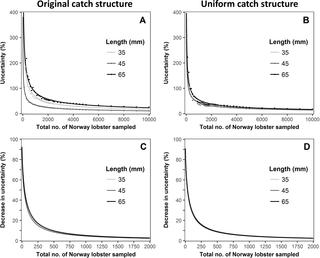PLOS ONE ( IF 2.9 ) Pub Date : 2018-06-21 , DOI: 10.1371/journal.pone.0199655 Tiago Veiga-Malta , Jordan Feekings , Bent Herrmann , Ludvig Ahm Krag

|
There is general pressure throughout the world’s fisheries for the industry to have greater involvement not only in the development of fishing gears but also in the testing and documentation of their effect. In the European Union, the Common Fisheries Policy of 2013, together with the proposed reform of the technical measures regulation, highlights the need for greater flexibility in fisheries through increased stakeholder involvement. To achieve this flexibility, there is a need for additional fishing gears available to the fishermen. A way to facilitate this is to have the industry take part in the development and testing of fishing gears, as well as collect data on their performance. However, to have a successful industry-collected data programme, fishermen have to be able to collect data on the length of a portion of the catch. In this study, we determine how many individuals need to be measured to correctly evaluate the relative selective performance of a new gear compared to a standard gear. The evaluation was carried out by analysing catch ratio curves, their associated uncertainties, and the trade-offs between uncertainties and sampling effort. Results show that with relatively small sample sizes (500 to 1000 individuals) it is possible to correctly evaluate the performance of a gear for a given species. By having the industry develop and test their own gears, as well as being involved in the collection of data, the number of potential gear solutions available to address the different issues emerging in the fisheries is increased.
中文翻译:

什么时候足够,足够?量化信息质量和渔具选择性数据采样工作之间的权衡
全世界的渔业普遍要求该行业不仅参与渔具的开发,而且参与其效果的测试和记录,以更大的力量参与其中。在欧洲联盟,2013年《共同渔业政策》以及拟议的技术措施法规改革,突显了需要通过增加利益相关者的参与来提高渔业的灵活性。为了实现这种灵活性,需要为渔民提供额外的渔具。促进此目的的一种方法是让该行业参与渔具的开发和测试,并收集有关其性能的数据。但是,要想获得成功的行业收集的数据计划,渔民必须能够收集有关部分渔获物长度的数据。在这项研究中,我们确定需要测量多少个人才能正确评估新齿轮与标准齿轮的相对选择性能。通过分析捕获率曲线,其相关的不确定性以及不确定性和采样工作之间的权衡来进行评估。结果表明,使用相对较小的样本数量(500至1000个个体),可以正确地评估给定物种的渔具性能。通过让该行业开发和测试自己的渔具,并参与数据收集,可用于解决渔业中出现的不同问题的潜在渔具解决方案的数量将增加。通过分析捕获率曲线,其相关的不确定性以及不确定性和采样工作之间的权衡来进行评估。结果表明,使用相对较小的样本数量(500至1000个个体),可以正确地评估给定物种的渔具性能。通过让该行业开发和测试自己的渔具,并参与数据收集,可用于解决渔业中出现的不同问题的潜在渔具解决方案的数量将增加。通过分析捕获率曲线,其相关的不确定性以及不确定性和采样工作之间的权衡来进行评估。结果表明,使用相对较小的样本数量(500至1000个个体),可以正确地评估给定物种的渔具性能。通过让该行业开发和测试自己的渔具,并参与数据收集,可用于解决渔业中出现的不同问题的潜在渔具解决方案的数量将增加。结果表明,使用相对较小的样本数量(500至1000个个体),可以正确地评估给定物种的渔具性能。通过让该行业开发和测试自己的渔具,并参与数据收集,可用于解决渔业中出现的各种问题的潜在渔具解决方案的数量将增加。结果表明,使用相对较小的样本数量(500至1000个个体),可以正确地评估给定物种的渔具性能。通过让该行业开发和测试自己的渔具,并参与数据收集,可用于解决渔业中出现的各种问题的潜在渔具解决方案的数量将增加。











































 京公网安备 11010802027423号
京公网安备 11010802027423号